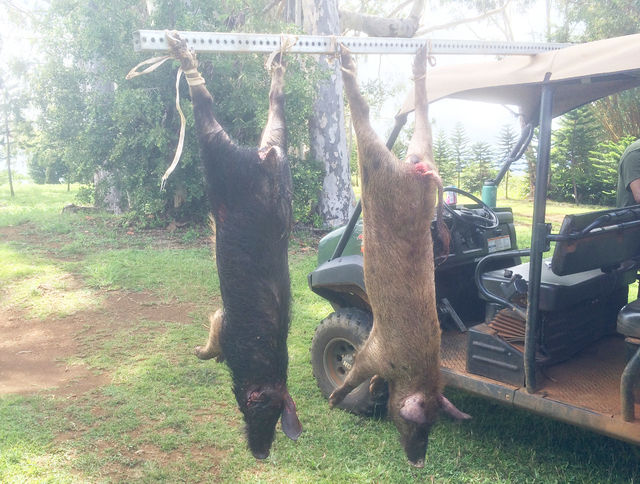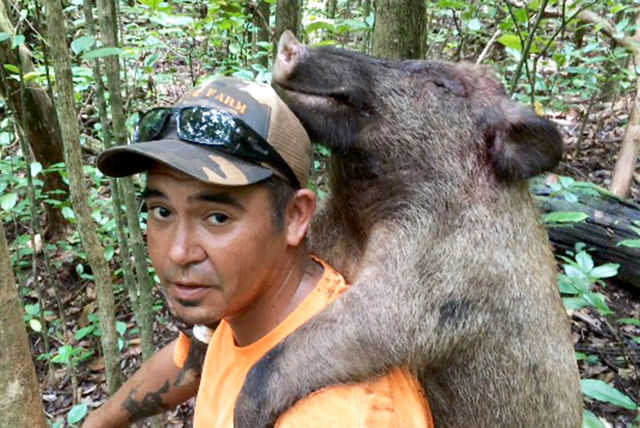LIHUE — The pig was dead on arrival. Flopped on its side, mouth open, with bite marks ripped across its face, the body was already attracting flies. Forrest Callahan knelt in the dirt, rolled the adolescent male pig onto its
LIHUE — The pig was dead on arrival. Flopped on its side, mouth open, with bite marks ripped across its face, the body was already attracting flies.
Forrest Callahan knelt in the dirt, rolled the adolescent male pig onto its back and tied the hooves together, while Sweetie, a 1-year-old hunting dog, stood watch.
Callahan lifted the pig’s tethered legs over his shoulders like the straps of a backpack. He wobbled under the weight of the 70-pound carcass. Then he set out, under the steamy blaze of a midday sun, over a stream and uphill into thick forest to arrive back at the ATV parked along a two-mile driveway leading to Grove Farms’ knolltop Iliahi estate.
Callahan, a third-generation pig hunter who took up the sport when he was 7, dropped the animal in the back of the vehicle and took a long swig from a bottle of water.
The back of his orange T-shirt was stained with dirt and the musty scent of the body he had just lugged about 300 yards. But he didn’t seem to mind.
“It’s all about the mele, the ruckus,” said Callahan, 31, of Kalaheo. “The pig roaring and the dogs yipping and you get all this adrenaline like you’ve got to get there and pin that pig and protect your dogs.”
In this case, the relatively small pig didn’t stand a chance. Pitted against Sweetie, Honi, Bullseye, Bonny and Big Boy — siblings with half Dogo Argentino blood — it could muster but a short fight.
Ubiquitous, menacing and ruinous to crops and native plantings, Kauai’s feral pigs are a problem.
They are widespread, found everywhere except isolated parts of the Napali Coast. And they’re capable of year-round breeding.
On the 40,000-acre Grove Farm property where Callahan is one of 200 hunters enrolled in a feral pig eradication program, the pigs decimate native plantings and dig up the forest floor so it can no longer support the growth of native species. By eroding the soil and uprooting shrubs and trees, the pigs invite the spread of invasives that choke out native landscaping.
Feral pigs also damage the ditch lines that provide water to farmers. And they pig out — pun intended — on corn and other crops.
“Just a month ago this yard was wasted,” said Boyd Gayagas, coordinator of Grove Farm’s pig eradication team, pointing to some freshly potted maile plantings. “In one night they do so much damage.”
Gayagas estimates there are thousands of pigs on the Iliahi property he manages, which includes farm land, private event space and ecological restoration initiatives.
“There are just so many pigs,” Gayagas said. “We can’t even make a dent.”
That’s why Grove Farms solicits the help of the U.S. Department of Agriculture — in addition to that of volunteer hunters — to help manage the property’s feral pig population.
For most hunters, killing pigs is about more than population control. It’s also a sport, as well as a means of putting food on the table.
“None of our meat ever gets wasted,” Gayagas said. “It’s not like you eradicate, kill and leave it. Because there is eradication like that happens on the island. But we take it seriously, not wasting. Plus we’re a little superstitious. We think if you waste, you don’t catch the next time.”
Feral pigs aren’t only problematic for Grove Farms. Three weeks ago, they decimated the National Tropical Botanical Garden’s sweet potato bed.
“When taro and sweet potato finally mature, they will relentlessly forage those beds every night until they get everything,” said Michael DeMotta, NTBG’s assistant director of living collections and horticulture. “It’s pretty bad.”
At McBryde Garden, NTGB is in the process of erecting a perimeter fence to keep the pigs out, DeMotta said. And it’s working to secure state permits to allow hired hunters onto the property to help with eradication efforts. The garden also has two traps.
These methods are helping, but based on observation, DeMotta said the island’s pig population nonetheless seems to be growing.
“It’s always nerve-racking, wondering every morning if the pigs got any of our rare native plantings,” he said.
For hunters at Iliahi estate, the goal is not total elimination, Gayagas said. Rather, it’s to manage the pig population by discouraging pigs from congregating in problematic locations, such as crop fields or native plant restoration sites.
“Even though we eradicate and we call it eradication, we don’t truly want to eradicate because that’s what we use for food and for sport,” Gayagas said. “We really just want to control the damage that they do. If they’re doing damage right here in the yard, then we will eradicate there. If a farmer calls us and is having a problem with the pigs, we will eradicate there.”
In addition to hunting with dogs and knives, bows and arrows or rifles, Gayagas said volunteer hunters also trap pigs and relocate them to areas away from crops, native plantings and the estate where private parties are held. Trapped pigs are typically killed only if they are so aggressive that attempting to relocate them could endanger the hunter.
The severity of pig damage fluctuates seasonally, Gayagas said. Around November, the pigs tend to start acting up.
For at least one reason, it’s good timing.
“Election season, all the politicians want smoked meat,” Gayagas said.




